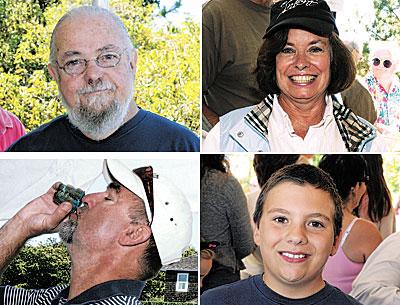An Ode To Clams, Red, White, and True

As a chowder judge it’s best to coat the stomach early in the morning with a basic, old-world foundation such as oatmeal with a bit of honey and milk that might have come from a cow in the backyard. Then it’s wise to fast until the tasting begins at the annual East Hampton Town Trustees Largest Clam contest and chowder competition.
Chowder has deep roots in the Northeast, especially here on Long Island. It should be taken seriously. Not only has the flesh of quahogs been a bountiful and ready source of food for hundreds of years, but, as though in homage to their innate value, beads made from the lustrous, white and purple lining of their shells were turned into wampum, coin of the Native American and early settlers’ realm.
For centuries, clams have been raked from the bottom of bays and harbors in early fall, plump from a summer of filtering only the finest phytoplankton from our fresh tides. They have been steamed open, their meats chopped into pieces of a size to fit a chowder maker’s design. Clam liquor, the liquid essence of the quahog, is collected and put aside. (More about this fundamental ingredient to come.) And, from the garden or the I.G.A, fresh vegetables are picked, diced, and added. In this neck of the woods chowder is not chowder without a hunk or two of salt pork. Herbs and spices are sown into the soup according to the chowder maker’s palette.
In New England white chowders rule. In New York and elsewhere, red, tomato-based, Manhattan chowders define the dish. East End chowder makers, as though caught between the two traditions, serve up a clear concoction, not white, not red, more of a thin chowder or fat soup stripped of tomatoey bells and milky whistles — a pure, tart, celebration of the quahog.
Fred Overton’s house chowder, served by the vat each year at the Largest Clam contest, is such a creation. His is a Bonac chowder based on a tried and true, handed down recipe that can be found on the Food page of today’s Star.
It is against this backdrop and Mr. Overton’s extremely high standard that the chowder tasting began during Sunday’s competition on Bluff Road in Amagansett.
Although fewer in number, this season’s chowder submissions were by and large bolder. There were five reds and four whites judged in five reds and four whites judged in separate categories by this reporter, his wife, Kyle Paseka, and East Hampton Town Councilman Peter Van Scoyoc. A fourth judge, Julie Stone, had to be brought in to break a tie in the red chowder taste-off.
There are various schools of thought when it comes to deciding a good chowder. A common mistake is to over-stuff chowder, especially a red chowder, to fill it with a veritable garden of vegetables until it resembles a “Bloody Mary without the vodka,” as Mr. Van Scoyoc put it. Speaking of which — and this comes to the point — Peter Beard of Montauk favors Bloody Marys using only vodka and Clamato juice. Clam juice is the magic ingredient, and it’s one that, alas, some chowder makers submerge in vegetation. In many a New England chowder, the salty, tart essence of our embayments is buried in butter. For shame.
In this judge’s opinion, two of the chowders entered in Sunday’s competition, one red, one white, committed the clam juice sacrilege. Most were very good, but in the end, Jim Sullivan’s two entries — one of them a juicy, slightly piquant, and not-overly-vegetated red, the other a classic and clammy New England — took top honors in each category.
As usual, trustees provided bushels of neck-size quahogs that were opened and served to the hundred or so who attended the event and washed the clams down with bowl upon bowl of Mr. Overton’s chowder. The town shellfish hatchery provided an educational exhibit on seed clams, and the Cornell Cooperative Extension had a setup demonstrating the importance of eelgrass to the area’s bivalves, while the biggest bivalves themselves waited patiently beside the scales and calipers to be judged.
As usual, Napeague Harbor seemed to produce the biggest clams. Linda Calder was the overall winner with a monster two-pound-nine-ounce chowder clam dug from Napeague Harbor. In the adult competition, Henry Flohr scratched around Accabonac Harbor before coming up with the 1.15-pound winner.
The first place Lake Montauk clam was a hefty 2.8-pounder dug by Nancy Peppard. Clifton Keyes won for Three Mile Harbor with a 1.1-pound clam.
In the junior competition, Avery Charron found a 1.7-pound clam in Accabonac Harbor. Edward Hoff III dug a very large 2.54-pounder from Napeague to be that harbor’s top junior digger and the top overall junior clammer, and Joe Hawkins’s 1.67-pounder took top honors from Three Mile Harbor.
